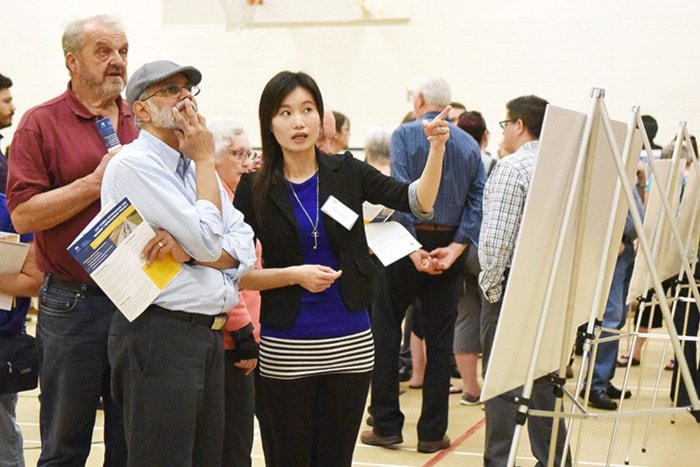Before ground is broken on the 216 Street Interchange and Highway 1 Improvement project this fall, Township residents are being given an opportunity to have their say.
The public engagement process for the $59 million project kicked off Thursday afternoon with an open house at Alex Hope Elementary.
As part of the B.C. on the Move Transportation Plan, the project includes building a new four-lane interchange at 216 Street with left hand turn lanes to access the freeway, and widening Highway 1 between 202 Street and 216 Street from four lanes to six. There will also be pedestrian and cycling access across the overpass, and an extension of HOV ramps to and from 202 Street.
According to project manager Sheila Hui, the new interchange will reduce congestion both on the freeway and in Langley.
"We are trying to improve the north/south connectivity between Walnut Grove and also the Williams neighbourhood that is coming on the south side (of the freeway)," Hui told the Times.
"We're trying to alleviate some of the congestion that occurs on Highway 1 right now by building the one extra general purpose lane from 202 to 216 (Streets). The province also does have plans in the B.C. on the Move in the next 10 years to widen all the way out to Abbotsford. So there is a combination of changes that the project is bringing to the neighbourhood."
Planners estimate the upgrades will reduce travel times along the corridor by up to 30 per cent, and will help relieve congestion on 200 Street and 232 Street.
"We have done some small-group consultation to begin the whole public consultation and engagement process. From those meetings, the feedback has been positive about the project," Hui said.
"People in Langley recognize that there is … growth coming into the region, and that there is an interchange needed for regional improvement, to support the traffic associated with the growth."
However, not everyone is welcoming the changes with open arms.
Jim and Linda Fleck have lived in the Forest Hills subdivision, located just off of 216 Street at 88 Avenue, for 29 years.
They are concerned about motorists taking shortcuts to the new interchange through their neighbourhood via 212 Street, a problem that is already occurring.
"A lot of people already from Walnut Grove come through our street to connect onto Telegraph Trail. So instead of going down 88 (Avenue) and taking a right at 216 (Street), they come along our street and they don't slow down at the park zone," Linda said.
These shortcuts are especially bad when there's traffic congestion or an accident on Highway 1, Jim added.
"I think that the entrance to Forest Hills at Telegraph Trail and 216 (Street) should be closed off, because that's going to become an arterial highway," Jim said.
The couple also worries that an increase in traffic flow will impact safety for students at both Topham Elementary, located on 91 Avenue at 216 Street, and École des Voyageurs Elementary, located on the corner of 216 Street and 88 Avenue.
Another area resident, David King, added that parking could also become a major issue in the area.
"With 216 Street, they've already got the signs up for a double road and I don't know where these people are going to park," he said.
"The stratas are going to have a real problem. That's my concern, but that's about three, four years down the road."
However, King said he also recognizes that the area is growing and improved infrastructure will be required.
"You have to adjust to the times and it's going to happen," he said.
One of the largest concerns brought to planners so far is noise, Hui said.
"We are building noise walls as part of the project, so we are consulting (with the public) in terms of the options for the finish (either wood or concrete) and also the location of where we're putting the noise wall," she said.
The cost of the project is being shared by the provincial government, the federal government and the Township of Langley. Construction is expected to last from the fall of 2016 to the fall of 2019.
Feedback from the public is being accepted until April 21.
To have your say, visit the website here, email 216interchange@gov.bc.ca or mail a letter to: Sheila Hui, A/Sr. Project Manager South Coast Region, Ministry of Transportation and Infrastructure, 310-1500 Woolridge Street, Coquitlam, B.C. V3K 0B8.
